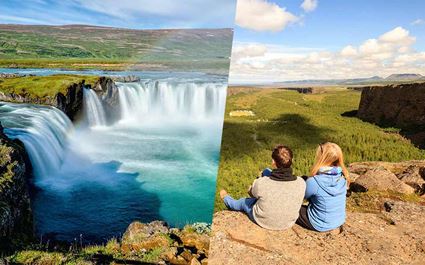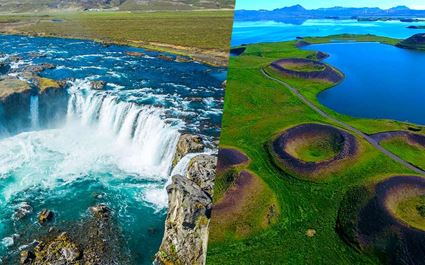Where is Hverfjall Crater Located?
Hverfjall Crater is located in northern Iceland and is part of Iceland's North Volcanic Zone. It's near the town of Reykjahlíð and about 10 kilometers (6.2 miles) east of the picturesque Lake Mývatn. It lies within the Krafla fissure swarm, a volcanic system active for millions of years.
How To Get To Hverfjall?
The main ways to reach Hverfjall are by car and bus. It is easily accessible and straightforward to get to.
If you are driving from Reykjavik, take the Ring Road (Route 1) north until you reach the town of Akureyri. Continue on the Ring Road for another 2 hours until you reach the junction with Route 848. Take Route 848 east for about 10 kilometers (6.2 miles) until you reach the signed turnoff for Hverfjall. Turn left onto the gravel road and follow it for 2 kilometers (1.2 miles) until you reach the parking lot.
If you are traveling by bus, take Flybus to Akureyri. From Akureyri, take the Strætó bus #56 to Lake Myvatn. You can then take a taxi or walk to Hverfjall from there.

General Information About Hverfjall
- Location Mývatn, North Iceland
- Part of Krafla fissure swarm
- Elevation 420 m (1,380 ft)
- Crater Width 1 km (0.6 mi)
- Crater Depth 140 m (459 ft)
- Created by Phreatomagmatic eruption
- Accessibility Car and bus
- Time to Visit All year
What Is Hverfjall Known For?
Hverfjall is known for its impressive size and shape. It is a tephra cone or tuff ring, which is a type of volcano with a bowl-shaped crater. It is almost perfectly round and nearly symmetrical. The volcano's massive crater rim reaches 200 meters (656 feet) in height. The crater is 1 kilometer (0.6 miles) wide and 140 meters (459 feet) deep. This makes it one of the world's largest and most well-preserved explosion craters. Its dark, steep slopes and deep crater create a unique and dramatic landscape that many find breathtaking and otherworldly. Visitors often describe it as a feeling of being on another planet.

History Of Hverfjall Volcano
Hverfjall erupted around 2,800 years ago, spewing ash all over the surrounding area and leaving behind the crater we see today. It was a powerful but brief phreatomagmatic eruption (steam-driven explosion) within the Krafla volcanic fissure. The eruption ejected ash and rock fragments, forming the distinctive tephra cone. During the eruption, a large section of the southern crater wall is believed to have collapsed, resulting in the crater's current shape.
Around year 900, lava flows from nearby Svörtuborgir nearly engulfed Hverfjall, adding to the area's volcanic history. The Krafla system, encompassing Hverfjall, has remained active, with 29 recorded eruptions since the settlement of Iceland. The crater has been providing insights into geological processes and history. It is a valuable site for scientists; studying ash deposits helps to understand past eruptions and predict future ones.
Today, Hverfjall is not only a geologist's workshop but also a powerful symbol of Iceland's volcanic nature. It is a popular sightseeing destination attracting tourists worldwide. Visitors can hike along marked trails to the crater's rim, discovering its vastness and the surrounding volcanic landscape.
Interesting Facts About Hverfjall Volcano
- Evidence suggests humans inhabited the area around Hverfjall as early as 9,000 years ago.
- Vikings arriving in Iceland witnessed the active landscape of the volcano and incorporated Hverfjall into their folklore and legends. The crater's unusual appearance and geothermal activity likely fueled their imaginations, weaving tales of hidden spirits and supernatural forces.
- Hverfjall served as one of the filming locations for the HBO series "Game of Thrones."

What To Do At Hverfjall?
Hike the Crater
The most popular activity at Hverfjall is hiking to the rim of the crater. The hike is relatively easy, taking about 20 minutes from the car park. Once you reach the top, you can hike the crater rim, which offers stunning views of the surrounding landscape. You will see Lake Myvatn, Dimmuborgir Lava Fields, and the Krafla volcanic system.
Explore the Crater Floor
If you are feeling adventurous, you can descend into the crater floor. However, be cautious as the terrain is uneven and loose, with fumaroles (steam vents) that can be dangerous. It is best to stick to the designated paths and be aware of your surroundings.
Learn the Geology
Hverfjall is a geologist's paradise. Take some time to learn about the formation of the crater and the volcanic processes that shaped the landscape. Information boards and guides are available to help you understand the crater's geological significance.
Best Time To Visit Hverfjall
Hverfjall is a year-round destination, so the best time to visit depends on your priorities and preferences.
Summer (June-August):
- Pros: Warmest weather (around 10-15°C or 50-60°F), long daylight hours (up to 20 hours in June), comfortable for hiking and exploring, most facilities and services available, and the opportunity to experience the midnight sun.
- Cons: Most crowded time, higher accommodation prices, potential for unpredictable weather with rain and wind.
Autumn (September-November):
- Pros: Fewer crowds, comfortable temperatures (around 5-10°C or 40-50°F), beautiful fall foliage colors, and the possibility of seeing the Northern Lights.
- Cons: Shorter daylight hours (down to 6 hours in November), some facilities and services may have limited hours, and colder weather requires more preparation.
Winter (December-February):
- Pros: Lowest crowds, a chance to see the Northern Lights at their peak, unique winter landscape with snow and ice, and the possibility of winter experiences like ice climbing.
- Cons: Coldest weather (around -5°C), some facilities and services may be closed, snow and ice can make hiking more challenging, and shorter daylight hours (down to 4 hours in December).
Spring (March-May):
- Pros: Fewer crowds, pleasant weather (around 0-5°C or 23-32°F), some wildflowers in bloom, longer daylight hours (up to 17 hours in May).
- Cons: Facilities and services may have limited hours, potential for unpredictable weather with rain and snow, and some areas may still be snow-covered.

Where To Stay Near Hverfjall?
- Berjaya Iceland Hotels is an upscale hotel with perfect views of Lake Myvatn and its surroundings. It features a variety of amenities, including a spa, restaurant, and bar.
- Hótel Laxá is a luxurious hotel located right on the shores of Lake Myvatn and offers breathtaking views of the local nature. It features a restaurant, bar, and spa.
- Fosshótel Mývatn is a modern hotel just a short walk from the Myvatn Nature Baths. It has comfortable rooms and good value for money.
- Dimmuborgir Guesthouse is a family-run guesthouse with various rooms and cottages, many with lake views. It is located in a quiet area near the Dimmuborgir Lava Fields.
- Hlíd Hostel is in a quiet area near the Myvatn Nature Baths, offering dorm beds and private rooms. It has a communal kitchen and lounge area.
- Camping sites are also available in the area, which can be a good option if you are on a tight budget or want to experience the outdoors.










